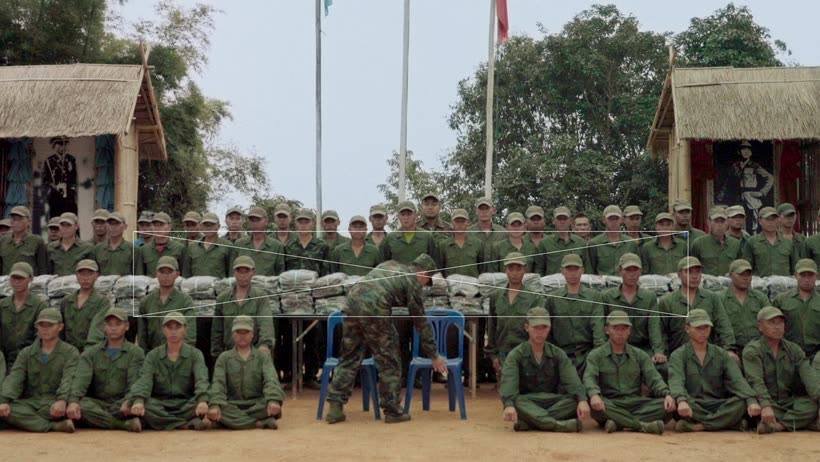
Everything is acceptable in ‘Soil Without Land’, at least as far as the main character is concerned, but it courageously offers a moral and pitiless assessment of the complex fates of the individual and the group caught up in the web of circumstances.
Jai Sang Lod, the son of a stateless Shan, recalls that in 2001 he fled from the clashes of the Burmese army and the Shan minority. After narrowly escaping the civil war, he is now forced to enter the Shansha army, thus returning to bloodshed and violence. This is Nontawat Numbenchapol’s great opportunity to penetrate the ranks of the Shansha army, an insurgent guerrilla force.
In his early years in life, Jai Sang Lod along with his parents and other Shan families, fled their country and relocated to a small village which was controlled by the Shan State Army (SSA) situated between Myanmar and Northern Thailand. From Ilaokhim’s account, true to her family’s ethnic background, Sang Lod is forced into the SSA along with hundreds of other youths with a lack of either ID or passport at the time after which all the young men were made compulsory to undergo military training. Nurtured in such an environment since childhood, he’s always viewed this as the kind of men he is meant to become.
He relocates from his family to somewhere unknown and experiences inhumane physical training on a daily basis. He wears the same uniform as hundreds of these other young men. Practicing aimlessly in the scorching sun, listening to lectures on masculinity, patriotism and the like, he starts training to become a soldier who is lifeguarded with the duty to fight for the sovereignty and liberation of the Shan from the highly oppressive Burmese military.
In a pivotal instance, the director captures the essence of a young man who is grieving the death of his mother alongside taking responsibility for his younger siblings since he is preparing to enter the army. This profoundly dictates Jai Sang Lod’s identity crisis while at the same time providing a clear lens to the true reality faced by numerous adolescents. On the contrary myself and Jai Sang Lod constantly feel as if we are achieving a form of equilibrium, this equilibrium lying somewhere in an undefined area in between being drowsy and wide awake. Ultimately, Jai Sang Lod adapts to being the daunting savior of Jiang’s systemic oppression along with the type of identity he could never truly be fond of. On the plus side, Nontawat Numbenchapol tackles the ambiguity tied with Shan state and the deep roots tied to the feeling of self-actualization, approval and military service.
For decades, the Shan ethnic group has faced displacement and domination by a civil war against the Burmese military, a tragedy that still continues today. The future of many ethnic minorities in Myanmar remains bleak with them battling an abusive regime in the form of ever shifting and changing governments.
Nontawat Numbenchapol criticizes the military regime in his introductory card in which tasks uses the documentary for a more goal-oriented perspective, which he himself describes lacking in. “Soil Without Lands” attempts to cover the struggles that deserters face when being conscripted instead of siding with or against the ethnic group.
Both the subject matter and form of the documentary underscore the lesser status of some nations. We can see the sham state army escaping in the opening scene through steep terrain, shot via drone on a road that is surrounded by a ridgeline. This shot raises questions about national boundaries in relation to the maps issued by the Burmese government and the international community, such as the ghost nations in the woods that are not marked on maps.
The director depicts such borderline territories in order to familiarize the viewer with territorial discourse, the nature of relations, and the imaginary of nations. The geo-body conceptualization is in fact brought up with the title: its referencing to a “soil” that may transform into a “land”, but currently describes “a nation-less region”. The outfits worn, musical orders, collective songs, and other elements have been worked in first to establish a nation, composed of synchronized moving parts, precise objectives and distinct movements.
In a way,“Doi Boy” serves as a spiritual continuation to the film doan, where identity related issues are shown again. These characters long to go to Thailand, which only features in “Soil Without Land” while Sachin illegal, exploited, and prostituted in “Doan,” it focuses on about the same topic as well. This idea is further investigated in the novel “Doi Boy”.
It should be noted that, “Soil without Land” is an emotional documentary based on the reality of Myanmar’s jungle guerrilla warfare.
In that regard, it provides a critique of the problem of the ghost nation, colonialism, and in the end indigenous land more broadly. It’s an astonishing, profound feature film that is never content with mere documentation but exposes the entirety of documentary philosophy. The film does not furnish a large amount of factual data that can assist the audiences in locating SSA in the broad spectrum of history and international relations, and makes a choice to use images and the narrative voice to get at a larger truth instead. The subjective experience of an individual and of a documentarist unearths the grand narratives underlying any experience of truth. This one will certainly not leave anyone cold.
For more movies like Soil Without Land (2019) visit solarmovie.







